Ride hailing is no small business. The growth this decade-old industry has experienced is exponential, and rightfully so.
Did you know that a new car’s value drops up to 11 percent once its tires hit public roads? Combine that with the impracticalities of heavy traffic, limited parking spots and ever-fluctuating fuel prices, we understand why car ownership is not a main priority amongst young adults today. An article by Forbes states that millennials, unlike the older generations, are opting out of car ownership as many either don’t need cars to go about their daily life or simply can’t afford them. For the first time since the global financial crisis, car sales are experiencing a sustained slowdown.
The emerging trend of migrating to big, even mega-cities also continue to shrink the radius of reach of life’s necessities. Everything is becoming – if not already – reachable within a few blocks. So, do you really want to hassle through climbing into your car just to drive down a few roads and spend the the same amount of driving time to find parking? What if you forgot to fuel up and have to make a gas station detour through the burdensome traffic? Driving doesn’t sound too fun now, does it. That’s where ride hailing enters. With a tap on the app, users get a personal vehicle driven directly to them, taking them to any destination set on the grid. Having the entire fee summed up to an amount shown on-screen, the added benefit and ease of mind then comes of not worrying about other logistics! With a generation that demands ease and efficiency, it is no wonder ride hailing is decisively trending as the preferred choice of commute in the 21st century.
The Malaysia Automotive Association (MAA) has released Malaysian vehicle registration data up to June 30, 2017, with the total number of vehicles on our roads standing at 13,288,797 units. With an average value of RM100,000, we have cars forming a RM 1.32T asset base. This capital infrastructure registers 5% utilization. Ride sharing companies figured out software that lets any of us with a smartphone tap into a previously fallow RM1.32T asset. There are approximately 2.5m ride sharing drivers in the US alone which has a population of 325.7m. The same ratio would give us a potential drivers pool 224,000 in Malaysia.
The industry works very well for its ‘suppliers’ too. As the service bridge the market gap of convenient transport, it also gives car owners easy means of earning side and even full income – and many drivers are tagging along. A 2016 statistic revealed to Dewan Rakyat states that between 50,000 to 60,000 personal car drivers are registered to provide ride hailing services in Malaysia. These numbers continue to increase. Although back then only one in five drivers reported to be full time, it is common to see drivers of all backgrounds and trades willingly enter this growing on-demand economy, given the flexibility of the nature of this market. In the case of Indonesia, the 84,000 ride hailing cars registered in 2017 have even surpassed the number of its direct competitors, taxis, who tallied in at 62,000 registered vehicles. As of last year, a major South-Asian player operating in 200 cities is reported to have 2.8 million drivers in the region alone.

With Energias estimating the global market for ride hailing to witness a 16.4 percent compound annual growth rate between 2018 to 2024, what does the future market of ride hailing look like in Southeast Asia? According to a research report published by ABI, 24 billion trips were expected to have successfully been completed last year, with a whooping 70 percent of them completed in Asia. Business Insider also reported that Southeast Asia’s ride-hailing market has grown fourfold since 2015, and will be worth $20 billion by 2025. Being the hub of the ride-hailing action, there is undoubtedly huge market opportunities for the Southeast Asian region, especially for well-backed newcomers who dare seize its potential. Who might that be, you ask? Well this year, the challenge is readily taken on by Eazi Car.
Eazi Car is a soon-to-launch e-Hailing company that uses online-enabled platforms to connect between passengers and local drivers using their personal non-commercial vehicles. Apart from providing riders safety solutions that integrates the GPS tracking system to individual SOS buttons on its mobile apps, Eazi Car have interestingly evaluated the future of the ride hailing market to not so much revolve around the innovation of technology. Instead, Eazi Car believes they can single handedly improve riders’ experience by increasing the motivation of their biggest asset – the drivers. By offering drivers medical benefits, they tactfully establish a preferable advantage to drivers over their competitors, as with any service providers, a happy, motivated driver makes the world of a difference for the quality of rides they give. Moreover, a cash reward system is used to merit its riders more directly over the prominent point based systems we see today. Drivers are also given a peace of mind from Eazi Car’s relaxed driver demands, by not enforcing on full time drivers strict target controls.
To realize the potential of their business model, Eazi Cars is set to raise funds through launching an equity crowdfunding campaign. The capital raised would be used primarily for marketing, expansion, and operations.
With pioneering companies just roughly a decade old, the industry is still young and fresh, awaiting for new ideas to emerge and actualize. Thus, ride hailing market share over the short and long-term is really just anybody’s take, so why not give Eazi Car a chance?
Author Profile

Latest entries
 Entrepreneur LifeApril 8, 2022Catch Sales this Festive Season!
Entrepreneur LifeApril 8, 2022Catch Sales this Festive Season! PerspectivesMarch 8, 2022About time to #BreakTheBias
PerspectivesMarch 8, 2022About time to #BreakTheBias PerspectivesAugust 31, 2021The Meaning of a Modern Merdeka
PerspectivesAugust 31, 2021The Meaning of a Modern Merdeka PerspectivesMay 12, 2021A Raya to Restore Our Freedom
PerspectivesMay 12, 2021A Raya to Restore Our Freedom





1 Comment
tinder site
January 25, 2021 at 1:17 amtinder sign up , tinder date https://tinderdatingsiteus.com/